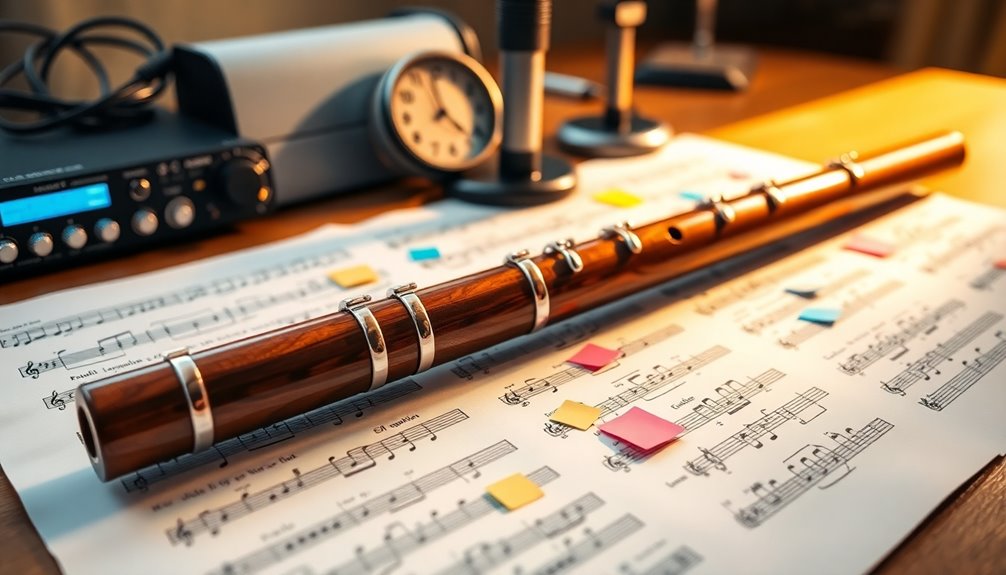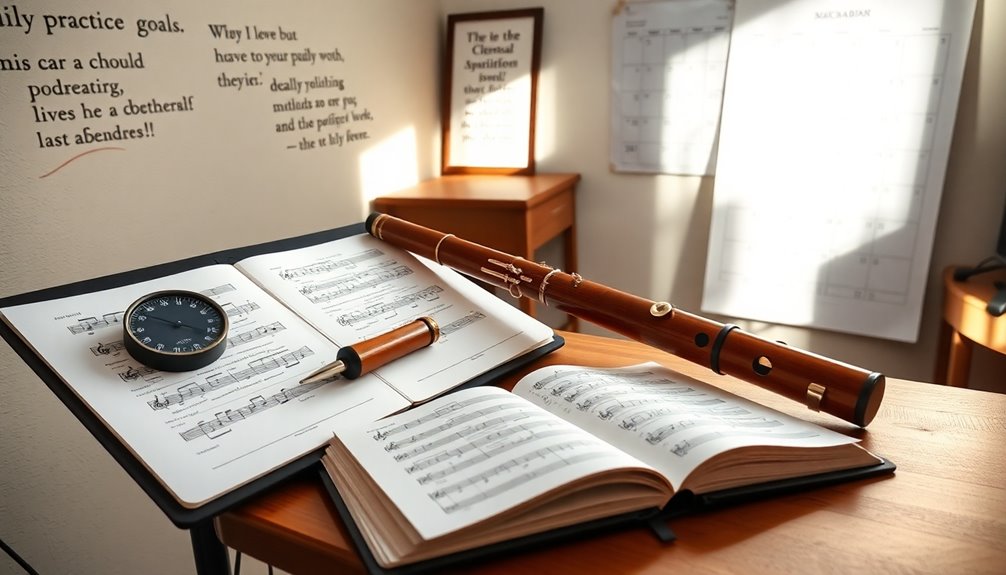To excel as a flutist, start by setting clear goals and tracking your progress. Utilize a practice journal to document your sessions and identify areas needing attention. Focus on breath control to enhance your sound quality, and incorporate daily warm-ups with scales and arpeggios. Break down difficult passages by practicing slowly and in segments. Don't forget to explore different musical styles to enrich your playing. Consistency is key, so maintain a regular practice routine. Each of these hacks can substantially impact your growth, and there's much more to uncover that can elevate your fluting journey.
Key Takeaways
- Set clear, achievable goals and track progress in a practice journal to maintain motivation and focus on improvement.
- Start each session with daily warm-ups using scales and arpeggios to build technique and sound quality.
- Break down difficult passages into smaller segments, practicing slowly to enhance accuracy and confidence.
- Experiment with diverse musical styles and techniques to keep practice engaging and expand your musical vocabulary.
- Record practice sessions to evaluate progress objectively and share with the community for feedback and encouragement.
Set Clear Goals

Setting clear goals is like charting a course on a map; it gives you direction and purpose in your fluting journey. When you embrace goal setting, you make your aspirations tangible. Start by identifying what you want to achieve—whether it's mastering a challenging piece, improving your tone, or preparing for an upcoming performance.
Break these aspirations down into performance milestones. These smaller, manageable targets keep you motivated and provide a sense of accomplishment along the way. For instance, if you aim to perform a solo, set milestones like perfecting a specific section or increasing your practice time gradually.
Regularly assess your progress; this reflection helps you stay on track and adjust your goals as needed. Additionally, incorporating a structured routine into your practice can enhance focus and optimize your skill development.
Consider sharing your goals with fellow flutists or friends. Not only does this create a sense of accountability, but it also fosters belonging within your musical community.
Utilize a Practice Journal

A practice journal is an invaluable tool for any flutist looking to enhance their skills and track progress. By keeping a journal, you can reflect on your practice sessions, identify patterns, and set yourself up for success.
Here's how to make the most of your practice journal:
- Daily Entries: Write about what you practiced each day, including specific exercises and pieces. This helps you see what works and what doesn't, allowing for effective practice reflections.
- Progress Tracking: Note any improvements, challenges, or breakthroughs you experience. This not only boosts your motivation but also highlights your growth over time.
- Goals and Adjustments: Regularly revisit your goals and adjust them as needed. If you notice certain areas need more attention, document those changes to keep your practice focused and aligned with your aspirations. Additionally, incorporating structured routines for practice can help you develop skills consistently.
Focus on Breath Control

Breath control is essential for any flutist aiming to achieve a beautiful, rich sound. To enhance your playing, focus on breath exercises that target diaphragm strengthening and airflow techniques. Incorporating these practices into your routine can considerably improve your sound quality. Additionally, mastering breath support will allow you to sustain longer phrases with greater ease and expression.
Adjusting your posture is equally important. Verify you're sitting or standing up straight, allowing your diaphragm to function effectively. Here's a quick reference table that outlines some effective techniques:
| Technique | Description |
|---|---|
| Breath Exercises | Practice inhaling deeply and exhaling slowly. |
| Diaphragm Strengthening | Engage your core while playing to support airflow. |
| Airflow Techniques | Experiment with different breath speeds and pressures. |
| Posture Adjustments | Keep your spine aligned and shoulders relaxed. |
| Daily Practice | Set aside time each day to focus on breathing. |
Incorporate Scales and Arpeggios

Incorporating scales and arpeggios into your practice routine can considerably enhance your technical skills and musicality as a flutist. By consistently working on these fundamental exercises, you'll build a solid foundation that allows you to tackle more complex pieces with confidence.
Here are three effective ways to integrate scale variations and arpeggio exercises into your sessions:
- Daily Warm-Ups: Start each practice with a few minutes dedicated to scales and arpeggios. Focus on different keys each day to keep things fresh and challenging.
- Explore Scale Variations: Don't just stick to major and minor scales. Incorporate modes and pentatonic scales to expand your musical vocabulary. This variety will make your playing more expressive.
- Connect with Music: Choose pieces that incorporate the scales and arpeggios you're practicing. This connection helps you understand their application and enhances your interpretative skills. Regularly practicing technical proficiency can lead to significant improvements in your overall sound quality and musical expression.
Use a Metronome

Using a metronome can greatly elevate your practice sessions and help you develop a strong sense of timing. By incorporating this tool into your routine, you'll experience a range of metronome benefits, including improved rhythmic accuracy and a more consistent tempo. Whether you're working on scales, arpeggios, or challenging pieces, a metronome can be your best friend. Additionally, it helps in developing timing skills essential for maintaining consistent rhythm.
Here's a quick guide to get you started:
| Metronome Setting | Purpose |
|---|---|
| 40-60 BPM | Slow practice |
| 80-100 BPM | Moderate tempo |
| 120-140 BPM | Upbeat sections |
| 160-180 BPM | Fast passages |
| Variable (increase) | Gradual complexity |
Begin with slower tempos to guarantee your notes are clean and precise. As you become more comfortable, gradually increase the speed. This practice not only solidifies your rhythmic accuracy but also builds your confidence. Remember, the metronome isn't just a timer; it's a partner in your musical journey. So, embrace it, and watch your skills flourish!
Record Your Sessions

Recording your practice sessions can be a game changer for flutists. By capturing your sound, you create opportunities for session analysis that can enhance your playing in ways you mightn't expect. Listening back allows you to identify areas for improvement and celebrate your progress.
Here are three key benefits of recording your sessions:
- Objective Evaluation: Audio feedback gives you an unbiased perspective on your tone, intonation, and rhythm. You might hear things you didn't notice while playing, leading to more targeted practice.
- Track Progress: Regularly recording your sessions provides a clear snapshot of your development over time. It's motivating to hear how far you've come!
- Refine Techniques: Use your recordings to pinpoint specific techniques that need work. Whether it's breath control or articulation, having a record makes it easier to focus on what needs improvement.
Incorporating mindfulness practices before your sessions can also enhance your focus and relaxation, making your recordings even more beneficial. Embrace this practice hack, and you'll find that recording your sessions transforms your approach to learning the flute.
It fosters a sense of community as you share your journey with others, bringing you closer to fellow musicians who are on similar paths.
Experiment With Different Styles

Often, flutists stick to familiar genres and techniques, but experimenting with different styles can dramatically enhance your musicality. Embrace the adventure of jazz improvisation; it encourages spontaneity and creativity. You'll discover how to let your emotions flow through your instrument, giving you a fresh perspective on familiar melodies.
Classical fusion is another exciting area to explore. By blending classical techniques with modern elements, you can create unique sounds that stand out. Don't shy away from world music, either; it introduces you to diverse rhythms and cultural nuances that can enrich your playing.
Consider incorporating contemporary techniques like extended techniques or multiphonics. These methods push the boundaries of traditional flute playing and can lead to innovative expressions. Moreover, exploring innovative repertoire can inspire fresh interpretations and challenge your playing style.
You might also investigate historical styles, learning how past flutists approached their craft. This knowledge not only deepens your understanding but can inspire your own interpretations.
Ultimately, genre blending opens up an exciting domain where you can combine influences to create your own voice. So, step out of your comfort zone, experiment with different styles, and watch your musicality soar. Your journey of exploration is what connects you with others in the vibrant world of music.
Break Down Difficult Passages

Tackling difficult passages can feel intimidating, but breaking them down into manageable sections makes the process much more approachable. When you encounter a challenging piece, try these strategies to alleviate the learning curve:
- Slow Practice: Start by playing the passage at a reduced tempo. This allows you to focus on accuracy and technique without the pressure of performance speed. It's amazing how much clarity you'll gain!
- Divide and Conquer: Split the passage into smaller segments, perhaps just a few measures at a time. Master each segment before moving on to combine them. This method helps build confidence and guarantees you're not overwhelmed.
- Rhythmic Variation: Experiment with different rhythmic patterns within the passage. For instance, try playing it with dotted rhythms or syncopation. This not only makes practice more engaging but also deepens your understanding of the music. Additionally, focusing on breath control techniques can significantly enhance your ability to tackle complex phrases with confidence.
Maintain Consistent Routine

A well-structured practice routine serves as the backbone of your progress as a flutist. By maintaining a consistent schedule, you're not just playing notes; you're building a habit that fosters improvement and mastery.
Start by setting aside dedicated time each day for practice. This approach enhances your time management skills and guarantees that you're prioritizing your growth as a musician.
To form effective habits, consider breaking your practice into focused segments. Spend time on warm-ups, technique, and repertoire. Rotating these elements keeps your sessions fresh and engaging while guaranteeing balanced development.
Consistency is key—try to practice at the same time each day to reinforce that habit formation. Over time, you'll find that this routine becomes second nature.
Don't forget to track your progress. Keeping a journal of your practice sessions can motivate you and help you identify areas that need more attention. Incorporating effective practice techniques into your routine can further enhance your skill development.
Remember, it's not just about quantity; quality matters too. By committing to a consistent routine, you're not just practicing; you're nurturing your passion and belonging to a community of dedicated flutists.
Embrace the journey, and let your routine guide you toward excellence.
Frequently Asked Questions
How Can I Improve My Finger Dexterity on the Flute?
To improve your finger dexterity on the flute, start incorporating finger drills into your daily practice.
Focus on simple exercises that target your finger movement, gradually increasing speed as you become comfortable.
Additionally, practice scale patterns in various keys; this not only enhances your dexterity but also solidifies your understanding of the instrument.
What Are the Best Warm-Up Exercises for Flutists?
To warm up effectively, start with long tones. They help you focus on tone quality and breath control. Choose a comfortable pitch and sustain it, gradually increasing your volume.
Next, incorporate scale patterns. Begin with major scales, then move to minor and chromatic scales to enhance finger dexterity and intonation.
How Do I Choose the Right Flute for My Level?
Choosing the right flute can feel overwhelming, like standing at a crossroads where each path leads to different experiences.
Consider your level and the materials; silver flutes offer warmth, while nickel-plated ones are budget-friendly.
Think about your budget, too; you don't want to compromise quality for price.
Research brands and try various models.
Finding the right instrument isn't just about sound—it's about connection and belonging in the music community you're enthusiastic to join.
What Should I Do if I Experience Pain While Playing?
If you experience pain while playing, it's important to address it promptly.
Start with pain management techniques, like taking breaks and stretching your hands and wrists.
Consider making ergonomic adjustments to your flute position or posture to reduce strain.
You might also want to check your grip and support your instrument more comfortably.
Don't hesitate to consult a professional for personalized advice; your well-being is essential for your musical journey!
How Can I Find a Good Flute Teacher or Mentor?
Finding a good flute teacher or mentor involves a few key steps.
First, look for teachers with solid qualifications, like degrees in music or years of experience. Ask about their teaching philosophy and approach.
Consider the mentorship benefits, such as personalized guidance and performance opportunities.
Don't hesitate to observe a lesson or ask for recommendations from fellow musicians.
Conclusion
By implementing these best practice hacks, you can elevate your flute playing to new heights. You might think you're too busy to commit, but even short, focused practice sessions can yield impressive results. Remember, it's the quality of your practice that counts, not just the quantity. So, set clear goals, stay organized, and embrace the journey of improvement. With consistency and dedication, you'll see the progress you've always dreamed of achieving. Happy practicing!






